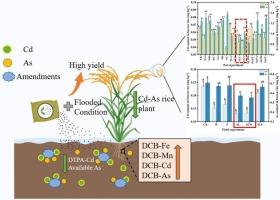Industrial by-products (ferrous sulfate minerals and stone powder) can serve as amendments to remediate Cd-As paddy soil, alleviating Cd-As accumulation in rice
IF 9
Q1 ENVIRONMENTAL SCIENCES
引用次数: 0
Abstract
Our previous research has shown that industrial by-products such as ferrous sulfate mineral and stone powder as amendments can remediate Cadmium (Cd) and arsenic (As) soil. However, their role in the soil-rice system is unknown. Therefore, this article explored the effects of the combined use of industrial by-products and commercial conditioners on the accumulation of Cd-As in weakly alkaline and acidic soil-rice systems. Potted experiments shown that SL (stone powder+ferrous sulfate mineral) and SLW (stone powder+ferrous sulfate mineral+Weidikang conditioner) could reduce the availability of Cd-As in soil by adjusting soil pH and CEC, increase iron film content on the root surface, strengthening the “barrier” for fixing Cd-As. Brown rice Cd was lower than the national food safety standard of 0.20 mg kg−1 (GB2762–2022). 1 % SLW could reduce brown rice As from 1.24 mg kg−1 to 0.83 mg kg−1. The results of field experiments confirmed the conclusion of pot experiments. SL and SLW not only reduced the accumulation of Cd-As in rice but also significantly increased rice yield by 16.58 % and 11.68 %, respectively. Compared to the two types of conditioning agents sold in the market, the material costs have been reduced by 79.1 % -86.5 % and 12.4 % -43.3 %, respectively. In summary, this study demonstrates that ferrous sulfate minerals and stone powder could efficiently remediate Cd-As pollution in paddy soil under different acid-base conditions, providing an application example for the resource utilization of industrial by-products for the remediation of Cd-As pollution in paddy soil.

工业副产品(硫酸亚铁矿物质和石粉)可作为镉-砷土壤改良剂,减轻水稻中镉-砷的积累。
我们之前的研究表明,硫酸亚铁矿物和石粉等工业副产品作为改良剂可以修复镉(Cd)和砷(As)土壤。然而,它们在土壤-水稻系统中的作用尚不清楚。因此,本文探讨了综合利用工业副产品和商业调节剂对弱碱性和酸性土壤-水稻系统中 Cd-As 积累的影响。盆栽实验表明,SL(石粉+硫酸亚铁矿物质)和 SLW(石粉+硫酸亚铁矿物质+卫地康调理剂)可通过调节土壤 pH 值和 CEC 降低土壤中 Cd-As 的可得性,增加根系表面的铁膜含量,增强固定 Cd-As 的 "屏障"。糙米的镉含量低于食品安全国家标准 0.20 mg kg-1(GB2762-2022)。1 % SLW 可将糙米中的砷含量从 1.24 mg kg-1 降至 0.83 mg kg-1。田间试验的结果证实了盆栽实验的结论。SL 和 SLW 不仅减少了镉-砷在水稻中的积累,还显著提高了水稻产量,增幅分别为 16.58 % 和 11.68 %。与市场上销售的两种调理剂相比,材料成本分别降低了 79.1 % -86.5 % 和 12.4 % -43.3 %。综上所述,本研究证明硫酸亚铁矿物和石粉在不同酸碱条件下可有效修复水稻田土壤中的镉-砷污染,为工业副产品资源化利用修复水稻田土壤中的镉-砷污染提供了应用实例。
本文章由计算机程序翻译,如有差异,请以英文原文为准。
求助全文
约1分钟内获得全文
求助全文

 求助内容:
求助内容: 应助结果提醒方式:
应助结果提醒方式:


